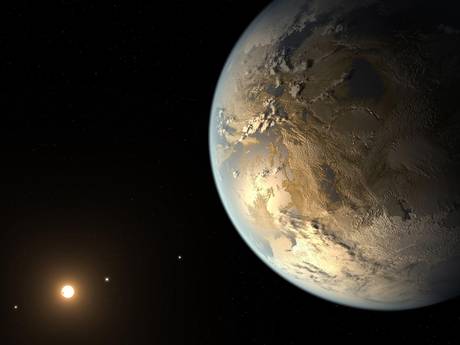Two most Earth-like planets found
02:30AM Sun 11 Jan, 2015

LONDON: Earth's closest twins have been found.
The two most Earth-like planets - Kepler-438b and Kepler-442b have been found orbiting red dwarf stars that are smaller and cooler than our Sun.
Kepler-438b circles its star every 35 days, while Kepler-442b completes one orbit every 112 days.
With a diameter just 12% bigger than Earth, Kepler-438b has a 70% chance of being rocky, according to scientists.
Kepler-442b is about one-third larger than Earth, but still has a 60% chance of being rocky.
Kepler-438b receives about 40% more light than Earth. In comparison, Venus gets twice as much solar radiation as Earth. As a result, the team calculates it has a 70% likelihood of being in the habitable zone of its star.
Kepler-442b get about two-thirds as much light as Earth.
The scientists give it a 97% chance of being in the habitable zone.
Astronomers have found eight new planets in the Goldilocks zone of their stars, orbiting at a distance where liquid water can exist on the planet's surface.
Among these eight, the team identified two that are the most similar to Earth of any known exoplanets to date.
This doubles the number of small planets (less than twice the diameter of Earth) believed to be in the habitable zone of their parent stars.
"Most of these planets have a good chance of being rocky, like Earth," says lead author Guillermo Torres of the Harvard-Smithsonian Center for Astrophysics (CfA).
To be in the habitable zone, an exoplanet must receive about as much sunlight as Earth. Too much, and any water would boil away as steam. Too little, and water will freeze solid.
"We don't know for sure whether any of the planets in our sample are truly habitable," explains second author David Kipping of the CfA. "All we can say is that they're promising candidates".
Prior to this, the two most Earth-like planets known were Kepler-186f, which is 1.1 times the size of Earth and receives 32% as much light, and Kepler-62f, which is 1.4 times the size of Earth and gets 41% as much light.
As with many Kepler discoveries, the newly found planets are distant enough to make additional observations challenging. Kepler-438b is located 470 light-years from Earth while the more distant Kepler-442b is 1,100 light-years away.
The team studied planetary candidates first identified by Nasa's Kepler mission. All of the planets were too small to confirm by measuring their masses. Instead, the team validated them by using a computer program called BLENDER to determine that they are statistically likely to be planets.
BLENDER was developed by Torres and colleague Francois Fressin and runs on the Pleaides supercomputer at Nasa Ames.
This is the same method that has been used previously to validate some of Kepler's most iconic finds, including the first two Earth-size planets around a Sun-like star and the first exoplanet smaller than Mercury. After the BLENDER analysis, the team spent another year gathering follow-up observations in the form of high-resolution spectroscopy, adaptive optics imaging, and speckle interferometry to thoroughly characterize the systems.
Those follow-up observations also revealed that four of the newly validated planets are in multiple-star systems. However, the companion stars are distant and don't significantly influence the planets.











